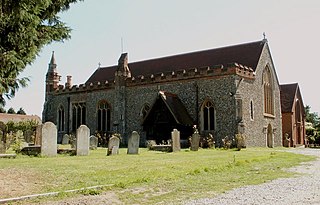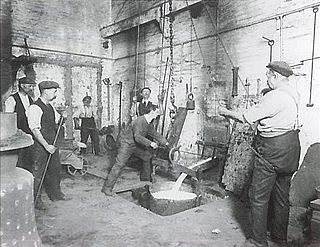Francis Henry Crittall (1860–1935) was an English businessman and philanthropist who in 1884 in the Essex town of Braintree instigated the manufacture of metal-framed windows by the Crittall Manufacturing Company Ltd. This company, now known as Crittall Windows Ltd, became the world's leading manufacturer of steel-framed windows. Crittall also funded the development of the model village of Silver End in Essex.

Essex is a county in the south-east of England, north-east of London. One of the home counties, it borders Suffolk and Cambridgeshire to the north, Hertfordshire to the west, Kent across the estuary of the River Thames to the south, and London to the south-west. The county town is Chelmsford, the only city in the county. For government statistical purposes Essex is placed in the East of England region.

Braintree is a town in Essex, England. The principal settlement of Braintree District, it is located 10 miles (16 km) northeast of Chelmsford and 15 miles (24 km) west of Colchester. According to the 2011 Census, the town had a population of 41,634, while the urban area, which includes Great Notley, Rayne and High Garrett, had a population of 53,477.
Crittall Windows Ltd is a notable English manufacturer of steel-framed windows, today based in Witham, Essex, close to its historic roots in the county. Its products have been used in thousands of buildings across the United Kingdom, including the Houses of Parliament and Tower of London, and are features particularly associated with the Art Deco and Modernist movements in early 20th-century architecture. The company's windows are also used in numerous buildings in North America and other parts of Europe, and were a feature of the RMS Titanic.
Contents
Francis Henry Crittall was the son of Francis Berrington Crittall and Fanny Godfrey. Crittall, in 1849, bought the Bank Street ironmongery in Braintree. After gaining work experience in Birmingham and Chester, Francis Henry took over the family business following his father's death, and in 1884 began to manufacture metal-framed windows. Five years later (1889), the Crittall Manufacturing Company Ltd was incorporated.

Ironmongery originally referred, first, to the manufacture of iron goods and, second, to the place of sale of such items for domestic rather than industrial use. In both contexts, the term has expanded to include items made of steel, aluminium, brass, or other metals, as well as plastics.

Birmingham is the second-most populous city in the United Kingdom, after London, and the most populous city in the English Midlands. With an estimated population of 1,137,100 as of 2017, Birmingham is the cultural, social, financial and commercial centre of the Midlands. It is the main centre of the West Midlands conurbation, which is the third most populated urban area in the United Kingdom, with a population in 2011 of 2,440,986. The wider Birmingham metropolitan area is the second largest in the United Kingdom with a population of over 3.7 million. Birmingham is frequently referred to as the United Kingdom's "second city".

Chester is a walled city in Cheshire, England, on the River Dee, close to the border with Wales. With a population of 118,200 in 2011, it is the most populous settlement of Cheshire West and Chester, which had a population of 332,200 in 2014. Chester was granted city status in 1541.
At this time the firm's output in a two-year period was 20 tonnes. In 1880 the company employed 11 men, by the 1890s this figure was 34, by 1918, 500. [1]
Under Crittall's management, the company expanded both domestically and internationally, manufacturing munitions during the First World War and then providing metal window frames for the UK government's post-war housing investment programme.
Crittall's portrait was painted by Augustus Edwin John in 1919, and the work was donated by the Crittall family to the National Portrait Gallery in 1994. [2]












